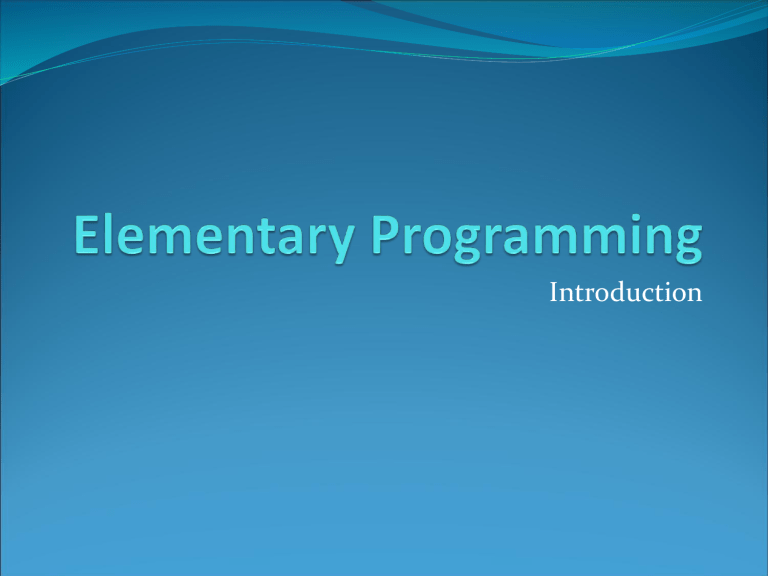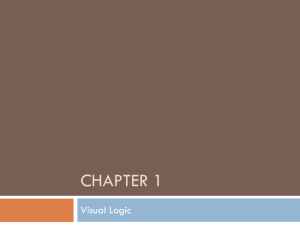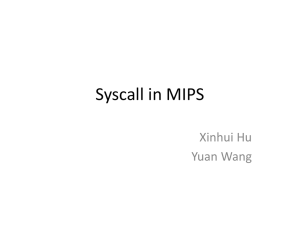ppt - DBS

Introduction
In today’s session…
What is programming?
Why should I learn programming?
Course Outline
Introduction to Programming Language
Introduction to Pascal
‘Hello world!’
‘Hello, <your name>!’
Variables
What is programming?
Process of writing, testing, debugging/troubleshooting, and maintaining the source code of computer programs (From Wikipedia)
To create a program (software) for usage of a particular sort, e.g. word processor (e.g. Microsoft Word,
OpenOffice.org Writer) for word processing (duh)
Why should I learn programming?
Logic skills – very useful in
Maths/Physics/Chemistry/…
Understand more about computer / information systems
Learn algorithms
Learn how to type – fast!
Represent the school in HKOI/CCC
Course Outline
Introduction
Pascal Syntax – I
Pascal Syntax – II
Pascal Syntax – III (depends on schedule)
Algorithms – I
Algorithms – II (depends on schedule)
HTML
CSS
PHP
3/5
6/5
10/5
13/5
17/5
20/5
24/5
27/5
31/5
Introduction to Programming
Language
Derived from human language
Syntax – grammatical rules
Symbol-like
Lots: Pascal, A+, A++, B, C, C--, C++, C#, D, D#, E, F,
F#, J, J++, J#, K, L, L++, M, Q, R, R++, S, T, X++, Y, Z,
VB, ActionScript, PHP, FORTRAN, Java, Javascript,
Python, etc.
For different purposes and with different syntax / ideology behind programming
Introduction to Pascal
‘Educational’
Syntax are human-like, easy to understand
Important in programming
Have practical use despite criticisms
Hello, world!
Classic approach to any programming language
Objective: Print ‘Hello, world!’
Code: program hello; var a : integer; begin writeln(‘Hello, world!’); end.
Hello, world!
Analysis
program hello;
‘;’ : to separate different statements
‘program’ : a special keyword, to specify the name of the program
‘hello’: the name of the program
* this statement can be ignored totally.
* note any ‘name’ cannot be special keywords or start with numbers. E.g. program 3x; or program program; is not valid, but program _3x; or program _program; is valid.
Hello, world!
Analysis (cont.)
var a : integer;
‘var’ : a special keyword, to notify the following statements are declaration of variables
‘a’: the name of the variable
‘:’: declare ‘a’ is which type of variable
‘integer’: a type of variable, which is integers (with range
-32768..32767)
* this statement can be ignored totally since this program has no use of variables
* note program hello; var a : integer; is valid.
* note var a, b, c : integer; is valid.
Hello, world!
Analysis
begin writeln(‘Hello, world!’); end.
‘begin’ : to specify the beginning of the program
‘writeln’ : a function, to write the value then with a line break
* Try this out: writeln(‘Hello’); write(‘Hello’); writeln(‘Hello’);
(What is the difference between writeln() and write() ?) writeln; is valid (what does this do?)
‘’’: to specify that the worlds ‘Hello, world!’ is a string, i.e. a series of characters, but not a variable.
* writeln(‘Hello’); and writeln(Hello);
‘end.’: to specify the end of the program
Hello, <your name>!
Objective: Print ‘Hello,’, then the name of the user who has inputted his/her name in the first place.
Code: program hello; var name : string; begin write(‘Please input your name: ’); readln(name); writeln(‘Hello, ‘, name, ‘!’); end.
Hello, <your name>!
Analysis
var name:string;
‘string’ : a type of variable, which is the compilation of characters
‘name’: the name of variable of string
* Variables come in different kinds, e.g. for integers, we have integer, longint, int64; for characters, we have char; for string, we have string, ANSIstring.
* Each type of variables have different operations.
* Variable can be assigned by ‘:=‘. E.g. name := ‘This is my name’ or a := 3;
Note that ‘’ is added to state that the values inside is a string!
a := a + 1 is possible!
Hello, <your name>!
Analysis
readln(name);
‘readln’ : to request input of variable to the user
‘name’: the name of variable of string
* Try read(name); instead of readln(name);, Or guess what’s the differences between readln and read.
Hello, <your name>!
Analysis
writeln(‘Hello, ‘,name,’!’);
‘,’ is used to separate strings and values in the variable ‘name’
* writeln(‘H’,’e’,’l’,’l’,’o’,’,’,’ ‘,’); is equivalent to writeln(‘Hello,’);
Variables
Integral types (0, 1, 2, 3, …)
Shortint (-128..+127)
Byte (0..255)
Integer (-32768..+32767)
Word0 (-65536..65535)
Longint(-2146473648..+2146473647)
Floating point types (0.1, 0.23, etc.)
Real
Double
Variables
Operations of Integral / Floating point types
‘+’, e.g. c := a+b;
‘-’ e.g. c := a-b;
‘*’ e.g. c := a*b;
‘/’ e.g. c := a/b;
‘div’ e.g. c := a div b;
‘mod’ e.g. c := a mod b;
‘()’ e.g. c := (a + b)*a;
Variables
Non-numerical
Char (characters, e.g. ‘a’, ‘A’, ‘!’)
String (an array of characters, usually max. at 255)
Array (a collection of variable of specific types with index) <- covered later
Operations
chr(x); ord(c); delete(str, x, y); fillchar(str, x, c);
Convert ASCII code (x) into character
Convert character (c) into ASCII code length(str); copy(str, x, y); pos(substr, str);
Find the length of a string (str)
Copy, starting from the x th element, y elements of string (str) val(str, x, e); str(x, str);
Find position of substr in str
Convert a string (str) into an integer (x)
Convert an integer (x) into a string (str) concat(str1, str2, …); Combine a string (str1) with another (str2, etc.) insert(str1, str2, x); Insert a string (str1) in the x th element of another (str2)
Delete, starting from xth element, y elements of string (str)
Fill the string (str) with a character (c) until string is (x-1) long
Last but not least…
Pascal compilers:
Free Pascal (Official HKOI/CCC compiler)
Dev-Pascal
Quick Pascal
Useful software:
Notepad++
Useful website/contact:
http://www2.dbs.edu.hk/club-soc/ecs
Lin Yin Long (L6D)







